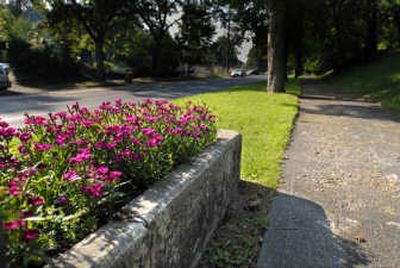History on horse trough hazy

Sometimes the easy-looking ones turn out to be the hardest.
The water trough at 19th Avenue and Grand Boulevard adjacent to Manito Park is 100 years old this year.
Who put it there? What’s the history behind it?
The archives in the Northwest Room of the Spokane Public Library and the library at the Northwest Museum of Arts and Culture – amazing resources for research into regional history – had no information about the water trough. Nor did the Friends of Manito group. Or the Spokane Parks and Recreation Department.
What is known is that the trough was put in place in 1907 at the park, which was a public recreation area at the end of a streetcar line. The approximately 6-foot-long concrete trough probably was cast in place, said Taylor Bressler, planning and development manager for the Parks and Recreation Department.
Once a refreshing source of water for draft horses, the trough today serves as a flower bed with signage noting its original intent. It can be viewed by drivers passing by on Grand Boulevard.
In the early part of the last century, Grand Boulevard was the only road up the South Hill, and it was lined with private property. Horses drawing wagons loaded with goods up the steep hill would be fatigued by the time they reached the Manito site, the only nondeveloped public land on the route.
Bressler said he never has seen anything in writing about the water trough, but there are stories – urban legends perhaps – that allege the trough was installed to give the weary animals a drink before they continued on their way.
The trough was put in place, the story goes, because neighbors had become upset by how wagon drivers stopped at the park and “encouraged” the tired animals to keep moving.
It’s interesting, Bressler said, that Spokane developed an ordinance stating that animals cannot be mistreated in public parks.
“I wonder if that came about because of the treatment horses got in the park at the top of the hill,” he said.
Merilee Dinneen, a member of the Friends of Manito board of directors, said the only reference she has seen about the water trough in any of the group’s historical materials is a letter of reminiscence received in 1991 from Lee J. Sahlin, who said he had grown up in the neighborhood where Manito Boulevard runs into the park.
In his letter, Sahlin wrote:
“The horse trough on Grand at 19th probably was built when the park was developed, and I understand (it was) used regularly to water horses. My only memories of horses drinking there were of the ones drawing the milk wagons and teams used for excavation.
“The dairies, which delivered milk door to door, used horses to draw the wagons as late as 1932 or so.
“The teams used for excavation were around until well after that. In digging foundations for the basements of houses, the teams of two horses drew scoops back and forth, scooping and emptying dirt on each pass until the hole was deep enough for a house foundation.”
So, we don’t know how or why the water trough was put in place at Manito or who installed it. But it’s nice to think it came about out of community concern for working horses.